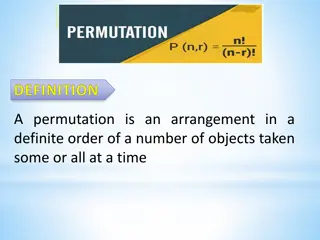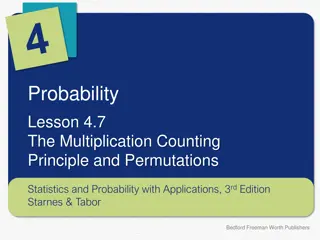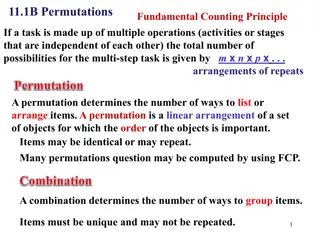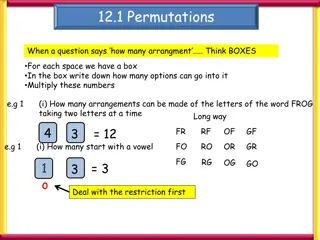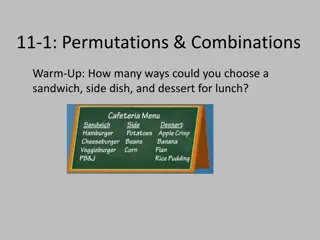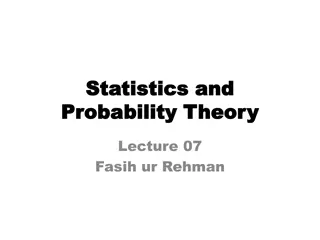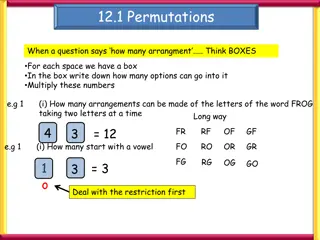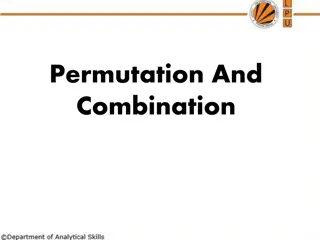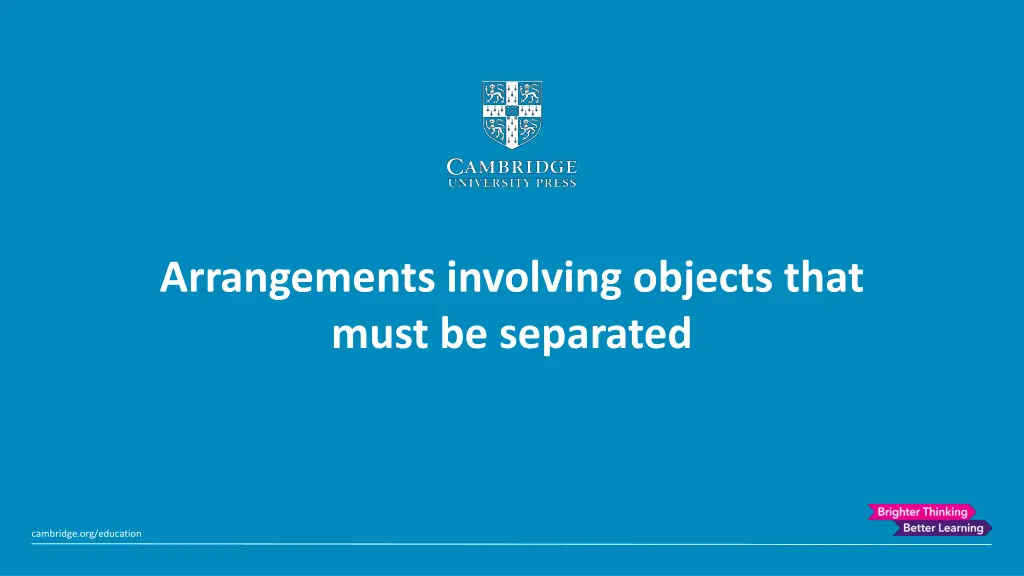
Solving Arrangements Problem with Separated Female Soldiers
Explore three different approaches to solving a problem of arranging two female and four male soldiers in a line where the females must be separated. Approach 1 involves investigating possible positions, resulting in a total of 480 arrangements. Approach 2 considers the concept of being next to each other as the complement of being separated.
Download Presentation

Please find below an Image/Link to download the presentation.
The content on the website is provided AS IS for your information and personal use only. It may not be sold, licensed, or shared on other websites without obtaining consent from the author. If you encounter any issues during the download, it is possible that the publisher has removed the file from their server.
You are allowed to download the files provided on this website for personal or commercial use, subject to the condition that they are used lawfully. All files are the property of their respective owners.
The content on the website is provided AS IS for your information and personal use only. It may not be sold, licensed, or shared on other websites without obtaining consent from the author.
E N D
Presentation Transcript
Arrangements involving objects that must be separated cambridge.org/education
Three different approaches to solving the following problem are offered and discussed. Two female soldiers and four male soldiers are to stand in a line on parade. In how many of the possible arrangements are the two females separated?
Approach 1 Investigate the possible positions of one female for each possible position of the other female.
Approach 1 We can arrange the four males after investigating the possible positions of the two females, F1 and F2.
Approach 1 With F1 in the 1st position, there are 4 possible positions for F2.
Approach 1 With F1 in the 2nd position, there are 3 possible positions for F2.
Approach 1 With F1 in the 3rd position, there are 3 possible positions for F2.
Approach 1 With F1 in the 4th position, there are 3 possible positions for F2.
Approach 1 With F1 in the 5th position, there are 3 possible positions for F2.
Approach 1 With F1 in the 6th position, there are 4 possible positions for F2.
Approach 1 There are 4 + 3 + 3 + 3 + 3 + 4 = 20 possible arrangements of the two females. In each of these 20 arrangements, the four males can be arranged in 4P4 = 4! ways. The solution to the problem is 20 4P4 = 20 4! = 480.
Approach 2 Use the fact that next to each other is the complement of separated .
Approach 2 Without restrictions, the six soldiers can be arranged in 6P6 = 6! ways. The two females can stand next to each other in 2P2 = 2! ways: or
Approach 2 This block of females and the four males can be arranged as five objects in 5P5 = 5! ways.
Approach 2 The two females are standing next to each other in 2P2 5P5 arrangements. The solution to the problem is 6P6 (2P2 5P5) = 480.
Approach 3 Place each female between a different pair of males or at either end of the line.
Approach 3 The four males can be arranged in a line in 4P4 = 4! ways.
Approach 3 Now we select 2 of the 5 spaces between or on either side of the four males and place the two females in the two chosen spaces.
Approach 3 This can be done in 5P2 ways. The solution to the problem is 4P4 5P2 = 480.
Discussion The three approaches have made use of different calculations to arrive at the same solution of 480. Approach 1: 20 4P4 Approach 2: 6P6 2P2 5P5 Approach 3: 4P4 5P2
Approach 1 This is a comparatively long method of solving the problem but, for two females, it does produce the correct answer. However, if the number of females were increased to three, this approach would prove troublesome, as it would be difficult to avoid counting duplicate arrangements.
Approach 2 The situations separated and next to each other are complementary (and exhaustive) only in the case of two females. If the number of females were increased to three, this approach would simply not work. For three females, the exhaustive situations are all separated , all next to each other and just two next to each other . The third of these situations must also be accounted for.
Approach 3 This approach works equally well for any number of separated objects. The complexity and the amount of working required do not increase as the number of objects increases. If there are n females and m males (and provided n m + 1), approach 3 tells us that all the females are separated in mPm m + 1Pn arrangements.
Extension questions 1. Three different cookery books and eight different novels are to be arranged on a shelf. a) In how many different ways can the eleven books be arranged? b) In how many of the possible arrangements are all three cookery books separated? c) In how many of the arrangement are exactly two of the cookery books placed next to each other? 2. Four boys and nine girls are to sit in a row on a bench. In what proportion of the possible arrangements are exactly two or exactly three boys sitting next to each other?
Answers to extension questions 1. a)11P11 = 39916800 b)8P8 9P3 = 20321280 c)11P11 (8P8 9P3) (3P3 9P9) =17418240 2. 13P13 (9P9 10P4) (4P4 10P10) = 4311014400. 4311014400 6227020800 100 = 69.2%





